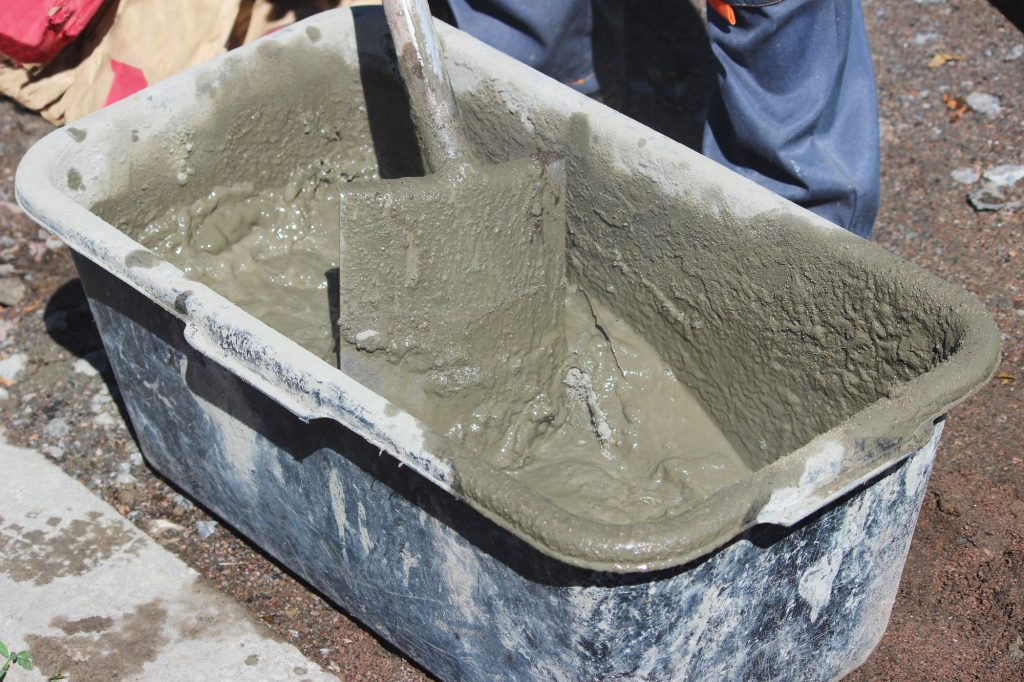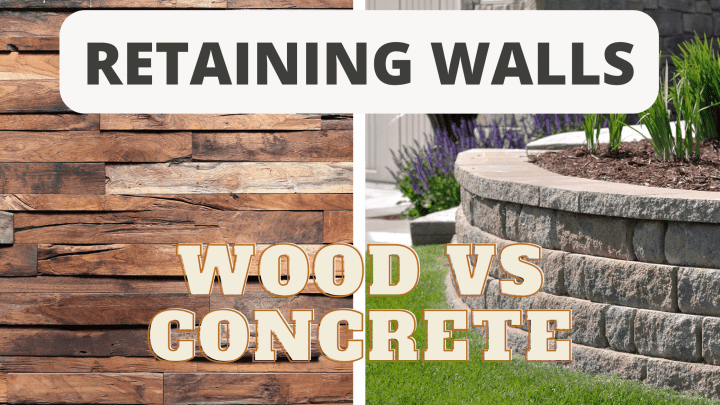Retaining walls are a great way to add both height and depth to your garden and provide usable flat space. The best kind of retaining wall is the one that uses a natural land structure, making it difficult for others to detect that there is an artificial boundary between different levels of the garden.
Both wood and concrete offer plenty of advantages and disadvantages, depending upon the height of your wall. They differ in construction, strength, and appearance. Both materials will require footers for larger walls but can stand alone as an acceptable material for smaller ones.
In this article, I’ll take you through which material is the ideal choice for a retaining wall project, the pros and cons of each, and how they’re constructed.
Are Wood and Concrete Retaining Walls Similar in Strength?
Wood planks and concrete blocks are both strong. Each material makes for a suitable retaining wall that will hold back large amounts of dirt and plants to the desired height.
Wood and concrete retaining walls are similar in strength when it comes to smaller retaining walls, but poured concrete is the strongest material for retaining walls, especially if installed with a concrete footer.
Wood retaining walls are more susceptible to rot from water damage, while concrete remains impervious to liquids. If you live in a humid area or expect a lot of rain, you’d probably want to go with concrete.
Having said that, wood retaining walls are more aesthetically pleasing than their concrete counterparts.
Poured concrete is very utilitarian and can be imposing to look at. Concrete will take the longest to install, but not by much if you have someone to help you out. However, wood planks will be much easier to install if you’re taking on a one-man job.
Overall, both materials make good options for your retaining wall as long as you consider the advantages and disadvantages of each option before making a final decision. If you want a deep dive, check out our guide on how much weight a retaining wall will hold.
Wood Retaining Walls
Many homeowners choose wood as their material of choice because it’s inexpensive and easy to find, especially in local hardware stores. It’s also lightweight yet strong enough to hold up against the weight of the soil you’re trying to move with your wall, making it an excellent material for small and large projects.
There are several types of wood available depending on the types of pests, weather conditions, and amount of usage you’re expecting.
Pros
- Inexpensive
- Easy to install
- It has a warm and decorative look
Cons
- It easily rots when wet.
- Wood can warp, creating openings for water penetration.
- Debris can collect in cracks or crevices over time
Concrete Retaining Walls
Using concrete is a wise choice for several reasons. First, it’s cheap and easy to find whether you’re purchasing from a hardware store or a larger home improvement store. It’s also much stronger than wood, so if you’ve got high retaining walls, concrete will be a good choice.
When planning your project, keep in mind that it might take longer than expected to have the wall constructed since the concrete mixture has an extended curing time which could add several days to the job.
Pros
- More effective for larger walls
- Concrete is impermeable.
- It comes in several different forms, including precast, poured concrete walls that are built onsite, and modular systems similar to interlocking blocks
- Strength makes it ideal for high retaining walls
Cons
- Generally more expensive than wood.
- Curing time could add days or even weeks to the project timeline
- Can cause delays depending on what you’re using the wall for (ex., plants might not be able to wait)
- It can be more difficult to install depending on the type of project
What Makes Poured Concrete Retaining Walls Stronger Than Wood?

When concrete is poured, the weight of the wet mixture creates a density that makes it difficult to move and handle. This means that as long as you pour your concrete retaining wall correctly, it should be sturdy enough to retain soil without collapsing or at least without too much risk of collapse.
Poured concrete retaining walls are stronger because all of the wall’s material flows from one single place and solidifies when it is cured. Cured concrete walls are very long-lasting, stable, and durable.
On the other hand, wood must be stacked when building a retaining wall, which creates multiple potential weak spots. The material can be used in the form of blocks or boards for retaining walls, but it will not have the same stability as concrete.
Poured concrete retaining walls are usually made with wire grids that help keep everything steady until it all hardens. These grids also make sure that there is no risk of mold forming behind the wall. Concrete retaining walls are also fireproof as well as pest resistant. They never need to be painted or stained, but you can choose the type of coating that suits your landscaping best.
How Are Concrete Retaining Walls Made?
A concrete retaining wall is an excellent choice for anyone who wants a sturdy barrier to keep dirt and debris where it belongs.
Concrete retaining walls are made with steel mesh to support the weight of the wet cement until it dries, which can take up to a week, depending on the thickness of the wall. A concrete footing is poured below the soil line for stability.
Concrete must cure for several weeks after it is installed before being exposed to the elements. A concrete wall feels solid, but an inspection should always be conducted to ensure no cracks or weak points in the foundation.
If you want a beautiful landscaped look without the maintenance of wood, think about adding a concrete retaining wall to your yard.
How Are Wood Retaining Walls Made?
When you want a low-maintenance landscaped area that will look beautiful for years to come, think about installing a wood retaining wall. Wood retaining walls can be quickly installed, and they require little maintenance.
Wood retaining walls are made with pressure-treated lumber to prevent rot within the wet soil. A trench is dug, then gravel is spread around them before they are filled in with dirt or sand. Lumber is then stacked and secured together with rebar posts.
Here’s a YouTube video showing the process:
Wood retaining walls are typically made from pressure-treated posts and beams that lock together with fasteners. This type of installation can be completed in a day by one experienced person.
The most common type of treated wood used for retaining walls is pressure-treated wood. This is a popular option as it resists rot and insects. However, over time the material may start to sag or lean outwards because of water penetration.
Pressure-treated lumber comes in two varieties:
- Softwood, such as fir or pine that weathers quickly; and
- Hardwoods such as redwood or cedar weather more slowly than softwoods.
The elements eventually take their toll on all wood retaining walls, forcing them to be either re-built or repaired sooner than later.
Conclusion
Concrete and wood retaining walls are both great options for your yard. Concrete is very durable and strong, but using wood makes for a quick installation. It takes less effort to maintain than cement or stone, which can be helpful if your property needs frequent repairs during the year.
Depending on the time and budget of your project, you may choose to go with either one, but it’s always crucial to conduct the necessary research before deciding — we’ve written a lot more about retaining walls here. I also strongly advise consulting a professional.

